Hunting Accident Statistics 2025: An All-American Hobby
Report Highlights: More than 14 million Americans apply for hunting licenses annually. Most hunting accidents occur due to human error.
80% of hunting accidents are attributed to human error.
A hunter’s failure to properly identify a target is the leading cause of firearm-related hunting accidents (37%).
There are between 3,000 and 4,000 reported injuries due to tree stands each year.
9% of reported hunting accidents in 2001 were fatal.
25% of all firearm-related hunting accidents involve a rifle.
23% of all firearm-related hunting accidents involve a shotgun.
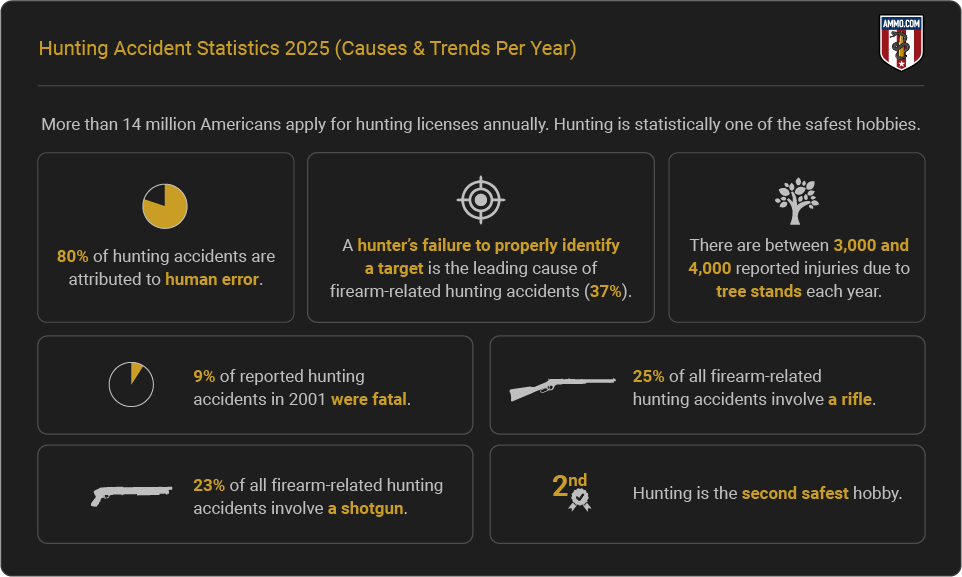
Related Studies: 4 Essential Firearm Safety Rules Every Shooter Must Live By | Youth Hunting: A Smart Parent’s Guide to Hunting with Kids | The Ultimate Hunting Caliber Chart.
Ammo.com strives to provide reliable information from reputable sources. You can view all sources used in this article HERE.
Methodology and Definitions
Hunting accidents encompass any and all unintentional injuries and deaths that occur during hunting. Many hunting accidents go unreported, although those that result in moderate or severe injuries are often reported to the International Hunter Education Association (IHEA).
This article contains hunting accident statistics from a variety of sources worldwide. All information in the following sections was cross-referenced with peer-reviewed studies, databases, and articles to ensure accuracy in reporting.
What Are the Main Causes of Hunting Accidents?
1,000 firearm-related accidents do happen yearly. Of those, 100 lead to fatalities. 2 There are between 3,000 and 4,000 accidents involving tree stands annually, which result in 300 to 500 fatalities. 7
Some sources estimate that 80% of hunting accidents occur due to human error. Accidents related to human error are broad and may include a hunter’s failure to check equipment or watch their step. 1 Estimates involving tree stands vary between faulty equipment, carelessness, or even unsafe practices such as horseplay.
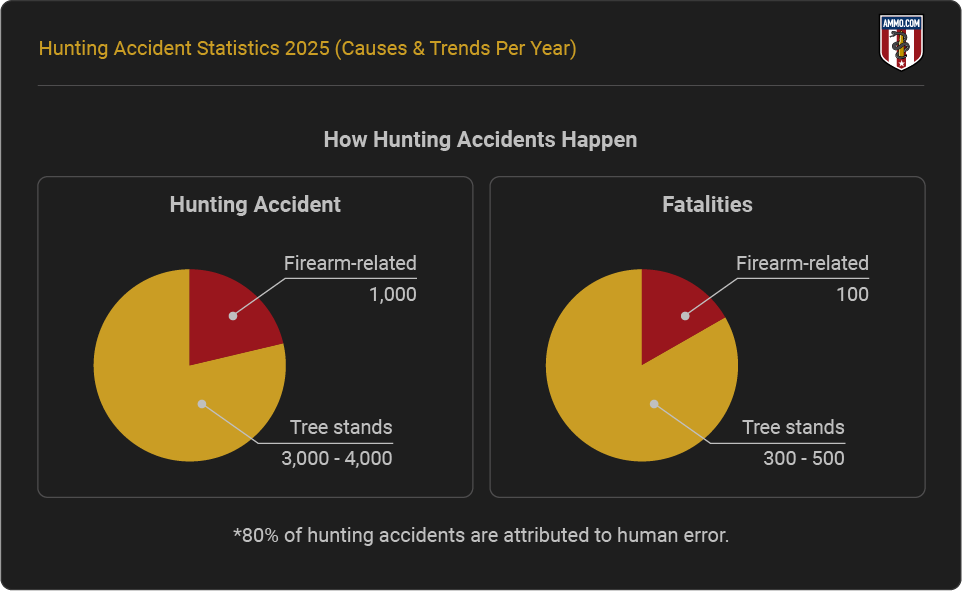
Gun-Related Accidents
According to a study analyzing accidental shootings between 2005 and 2015, 13.8% of unintentional shooting deaths were related to hunting. 8
IHEA tracked 598 firearm-related deaths involving hunting between 1974 and 2020. 7 The majority of those incidents were attributed to hunters’ negligence, followed by accidental discharges. Very few were attributed to ricochets or missed targets.
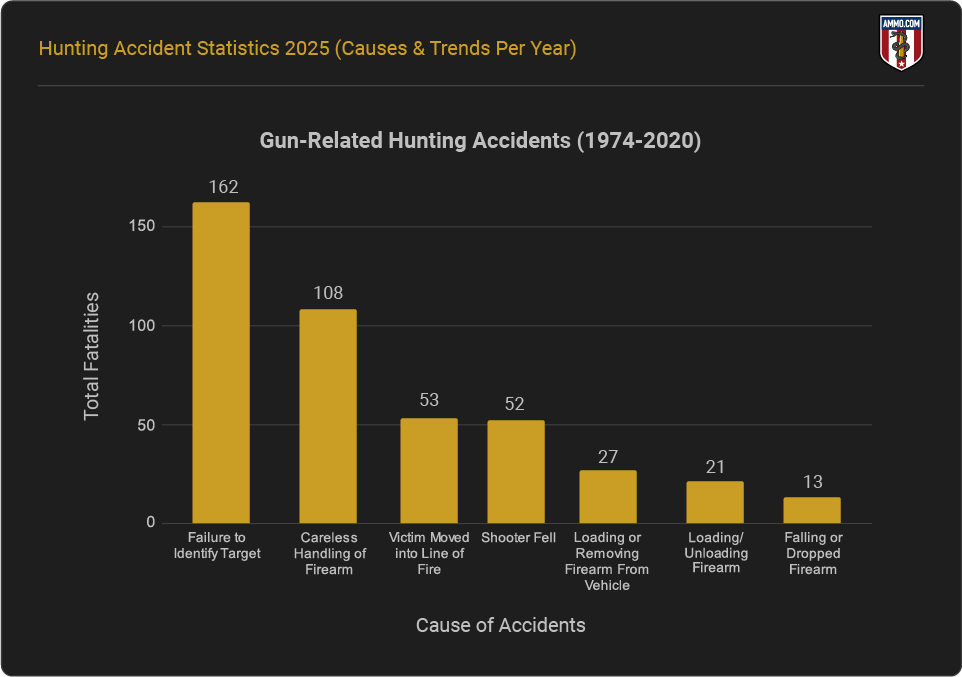
Falls From Tree Stands
Some sources estimate between 3,000 and 4,000 injuries result from tree stand falls each year. (Source 5) The majority of serious injuries (95%) occurred when hunters weren't wearing harnesses. 6
According to the Mayo Clinic, most falls from a tree stand occur at 15 feet, which can cause serious injuries to hunters. 9
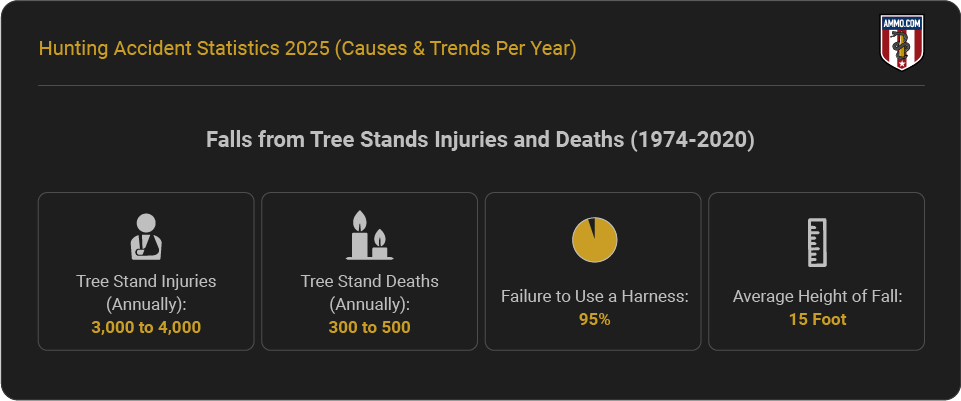
Severity of Hunting Accidents
There were approximately 14 million hunters in the U.S. in 2022. 11 It is estimated that 0.03% of all hunters are injured or killed due to hunting accidents each year. Each year, 87.5% of hunting accidents are nonfatal. 1, 2, 4, 8, 10
The Mayo Clinic states that falls from tree stands and heart attacks pose the highest risks to hunters. Other sources state that firearms inflict the highest number of injuries.

Non-Fatal Accidents
In 2001, IHEA reported 800 hunting-related accidents. Of these accidents, 90% (721) were nonfatal. 10 Two hundred twenty-six involved self-inflicted injuries, while 495 involved two-party accidents.
Between 2016 and 2020, 56% of hunting accidents recorded in the U.S. were nonfatal. Of the 24 nonfatal firearm-related incidents listed, three were listed as severe injuries, and over half were injuries to arms, legs, feet, and hands.
Fatal Accidents
IHEA published a report of 79 fatal hunting-related accidents in 2001. Twenty-nine fatalities resulted from hunters’ failures to identify targets; 11 resulted from hunters’ inability to see victims; 10 resulted from hunters firing while swinging on game (the hunter follows a moving target with their firearm). 10
Self-Inflicted Accidents
According to IHEA, there were 630 recorded firearm-related hunting deaths in 2001. Eighty-five of these shootings were self-inflicted, and 545 injured someone other than the shooter.
Between 2016 and 2022, 42 nonfatal incidents were reported to IHEA. Twenty-two of the nonfatal shootings were self-inflicted; 19 were not. 8
Two-Party Accidents
Two-party hunting accidents are more likely to occur than self-inflicted injuries. In 2001, there were 555 injuries and deaths related to two-party accidents versus 245 self-inflicted accidents. 10
Hunting Gun Accidents by Type of Weapon
Shotgun
Between 1976 and 2020, IHEA recorded 735 hunting-related fatalities involving a firearm. Of these, 42% (312) involved shotguns.8
A study from Germany spanning 1961 to 1992 revealed that 63% of firearm injuries related to hunting were attributed to shotgun shells with pellets; 3.5% were attributed to to shotgun slugs.
Rifle
Of the 735 firearm fatalities related to hunting in the U.S. between 1974 and 2020, 49% (360) involved a rifle. 8
The 1961-1992 study from Germany shows that fewer hunters were injured with rifles. Only 31% were shot with rifle cartridges during that time frame. 3
Bow and Arrow
Bow and arrow (or crossbow) fatalities are much less common than firearm fatalities. Between 1976 and 2020, IHEA tracked only 14 fatalities related to these instruments. 8
Common Injury Locations in Hunting Accidents
Hunting accidents most often result from tree stand falls and commonly lead to spinal cord injuries, head injuries, and broken bones. 14, 15, 16 Injuries to the feet and legs are most common in non-fatal hunting accidents and are often attributed to knives, bullets, arrows, and bolts. 7, 9
Injuries to the head and abdomen are most likely in firearm-related hunting fatalities. 7, 16
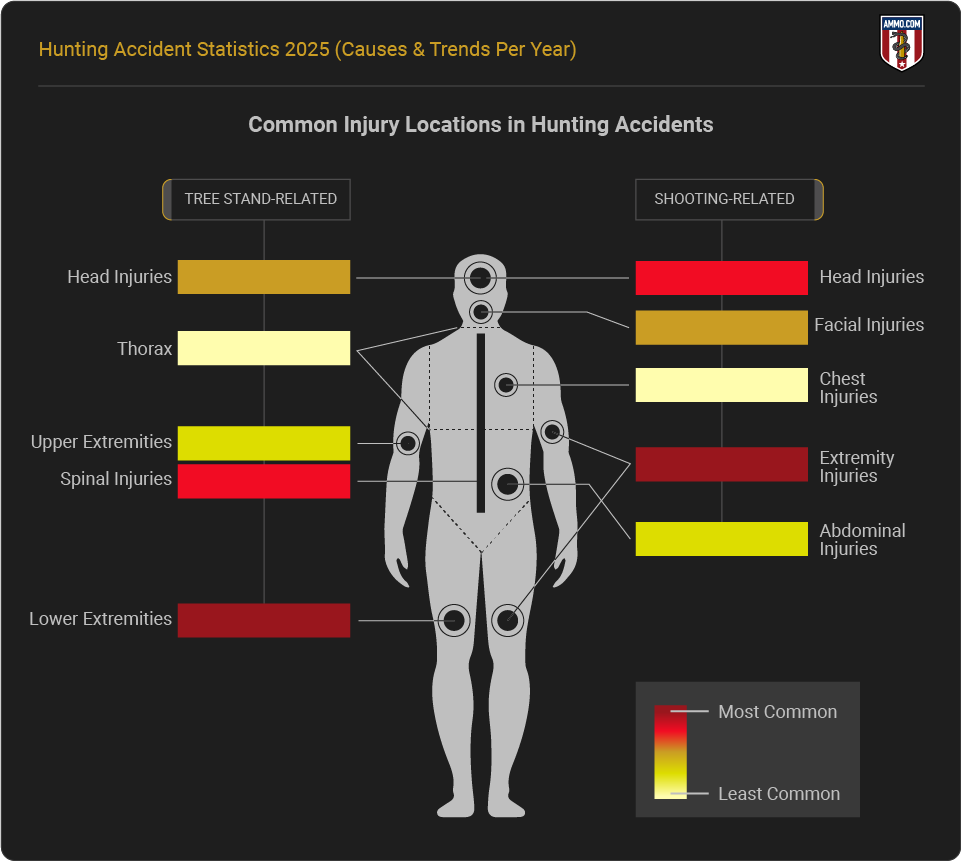
When Do Incidents Usually Happen?
Based on some estimates, half of all hunting accidents occur within the first or last hours of daylight. 1
According to the IHEA report, from 1976 to 2020, most hunting fatalities occurred in sunlight. Four hundred fifty-eight incidents were recorded, listing weather conditions and daylight factors. Two hundred thirty-six incidents occurred during sunlight, 106 occurred during overcast conditions, 52 occurred at dusk, 37 in the dark, and 28 at dawn. 7
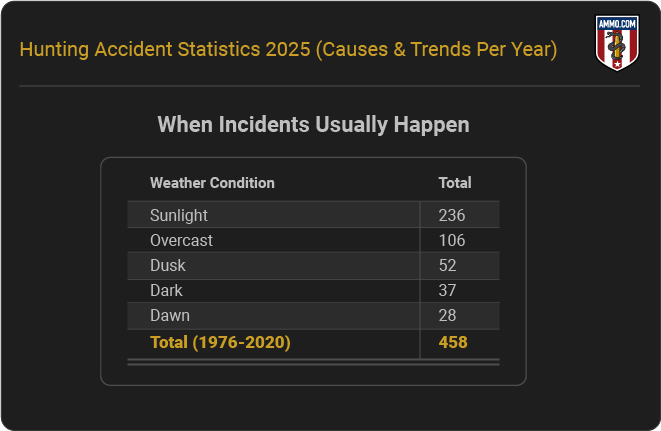
How Do Hunting Injury Rates Compare?
According to a 2017 National Shooting Sports Foundation (NSSF) report, there were 5,127 tackle football-related injuries for every 100,000 players, 2,196 skateboarding-related injuries for every 100,000 skaters, and only 38 hunting-related injuries for every 100,000 hunters.
This means that, per participant, football players are 135 times more likely to experience an injury, and skateboarders are 58 times more likely to experience an injury than hunters.
Although the data shows that hunting may be safer per participant, it also fails to account for factors such as injury severity, frequency (how often hunters participate in this sport compared to football players and skateboarders), duration of the activities, and the level of physical contact involved in each activity. (Source 11)
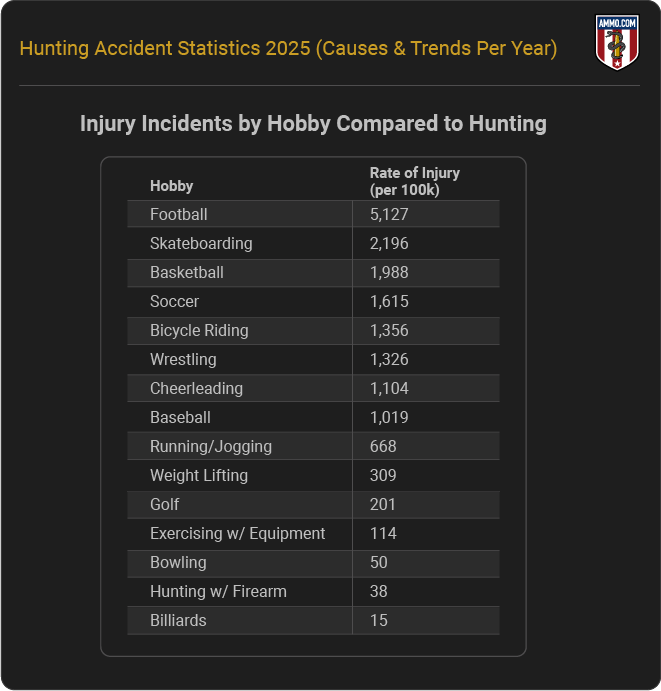
Wrap-Up
Hunting accidents do happen, though they’re often attributed to human error. Firearm-related incidents cause more deaths, while tree-stand accidents cause more injuries.
Sources
- How Many Hunters in the U.S. (2025)
- Main Causes of Hunting Accidents
- Firearm Fatalities and Injuries from Hunting Accidents in Germany
- Firearm-Related Accident Statistics
- Aim for Safety in Your Tree Stand
- Hunting Accident Statistics: Fatalities, Injuries, and Tree Stand Accidents
- Hunting Incident Database
- Unintentional Firearm Deaths in the U.S.
- Keeping Hunters Out of the Hospital
- IHEA: Annual Report of Hunting and Hunting-Related Accidents
- Firearm-Related Accident Statistics
- Hunters Celebrate More Than Percent Surge Over Past Five Years
- Spine and Spinal Cord Injuries After Falls From Tree Stands During the Wisconsin Deer Hunting Season
- Tree Stand Falls: A Persistent Cause of Neurological Injury in Hunting
- Injury Pattern Due to Falls from Hunting Stands
- Unintentional Firearm Injuries Remain Prevalent Over a 12 Year Experience at a Rural Midwestern Level 1 Trauma Center
Infographics
- Are Guns & Ammo The New Gold? Why More Americans Are Arming Themselves
- The Greatest Gun Salesman In America: President Barack Obama
- Shooting Straight: How Both Presidential Candidates Have Changed On Gun Control
- President Obama: (Still) The Greatest Gun Salesman in America
- An Inconvenient Truth: How The Obama Administration Became Earth's Largest Arms Dealer
- Armed Drones: President Obama's Weapon of Choice
- COVID-19 Data Study: Ammunition Sales Continue to Soar in Response to Coronavirus Panic
- Data Study: 18 Months of Ammo Sales during a Pandemic, Protests, and the Biden Presidency
- Data Study: U.S. Ammo Sales Surge Following Russian Invasion of Ukraine
- Most Gun-Friendly States in 2024
- Worst States to be a Gun Owner (2024 Updated)
- Children & Firearms: Definitions and Demographics Make All the Difference
- Urban Violent Crime & Legal Gun Ownership
- Gun-Free School Zone Laws & School Shootings (2024 Updated)
- Gun Control Laws and Enforcement Trends 2024
- Gun Ownership by State (2024 Statistics)
- How Many Gun Owners are in America? (2024 Statistics)
- Concealed Carry Crime Stats 2024
- Accidental Shooting Statistics: A Review of Unintentional Firearm Deaths from 1979-2024
- America’s Stolen Guns: A Silent Contributor to Gun Crimes in the U.S. (2024)
- Gun Violence Statistics 2024: Comprehensive Look at the Data
- Gun Laws vs. Crime Rates in 2024: A Comprehensive Analysis
- Gun Death Statistics by Caliber: A Review of Calibers and Crime in 2024
- Anti-Gun Control Arguments 2024: Facts Gun Control Lobby Suppress
- Guns in the Home Statistics: The Effects of Firearms in the Home in 2024
- Gun Deaths in the US: Analyzing At-Risk Demographics in 2024
- How Many Guns in the U.S.: All About America’s Firearms in 2024
- Gun Facts in the U.S. 2024: The Reality of Firearms in America
- Defensive Gun Use Statistics: America’s Life-Saving Gun Incidents (2024)
- Correlation Between Mass Shootings and Prescription Drugs (2024 Study)
- Gun Ownership by Gender in 2024: Closing the Gender Gap
- Murders by Weapon Type: September 2024 Statistics
- Gun Violence Among Black Americans: September 2024 Statistics
- The Ultimate Hunting Caliber Chart: Best Cartridge Per Species
- How Old Do You Have to be to Buy a Gun: A State Guide 2024
- Most Popular Guns in the U.S.: The Must-Have Guns in 2024
- Stray Bullet Deaths: Accident and Injury Statistics in September 2024
- Mass Shooters by Race: Demographics of Assailants 1966-2024
- Ammunition Limits By State in 2024: How Much Ammo Can You Buy?
- Why Do Americans Own Guns in 2024?
- How Many Americans Want Stricter Gun Laws in 2024?
- How Many Households in the U.S. Have a Gun in 2024?
- What Percentage of Gun Deaths are Suicides in 2024?
- Average Age of Mass Shooters in the U.S.
- Firearm Ownership in America by Year
- US Firearms Deaths Per Year: A Collective Report 1968-2024
- Percentage of Americans Owning Guns in 2024
- Texas Gun Ownership: Total Numbers, Trends, and Most Popular Guns
- Gun Ownership Statistics Colorado 2025: Trends & Numbers
- Hunting Accident Statistics 2025 (Causes & Trends Per Year)
- Banned Guns & Ammo List: A 2025 Review by State
- 3D Printed Gun Laws By State
- How To Build a Home Shooting Range: The Ultimate Guide
- States With the Highest Murder Rates
- Best Self-Defense Weapons for Women
